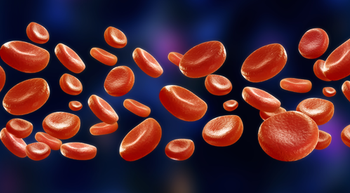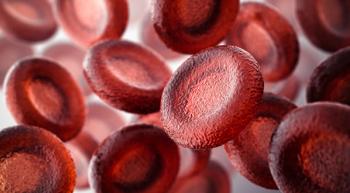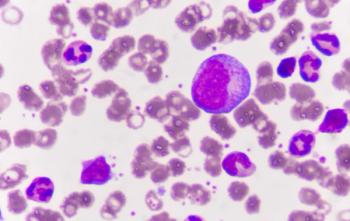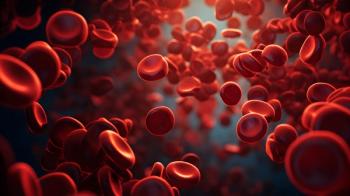
Firstline Nivolumab/Chemotherapy Continues To Outperform Chemotherapy Alone for Advanced Gastric/GEJ/Esophageal Cancer At 3-Year Follow-Up
In an all-randomized population of patients with advanced gastric cancer, gastroesophageal junction, or esophageal adenocarcinoma, adding nivolumab to chemotherapy yielded a 21% reduction in the risk of death.
Frontline nivolumab (Opdivo) plus chemotherapy continued to confer a survival benefit to previously untreated patients with advanced gastric cancer, gastroesophageal junction (GEJ) cancer, and esophageal adenocarcinoma, including those with a PD-L1 score of 5 or more, along with those in the all-randomized population, according to a 3-year follow-up from the phase 3 CheckMate-649 trial (NCT02872116). The findings showed that the combination inspired deeper responses than chemotherapy alone, confirming its benefit as the new standard of care in this setting, according to investigators. 1
The updated findings shared during the 2023 Gastrointestinal Cancers Symposium showed that at a minimum follow-up of 36.2 months, the median overall survival (OS) was 14.4 months (95% CI, 13.1-16.2) with nivolumab plus chemotherapy (n = 473) and 11.1 months (95% CI, 10.0-12.1) with chemotherapy alone (n = 482) in the population of patients with a PD-L1 combined positive score (CPS) of 5 or higher (HR, 0.70; 95% CI, 0.61-0.81). The 3-year OS rates were 21% and 10%, respectively.
In the all-randomized population, the addition of nivolumab to chemotherapy (n = 789) resulted in a 21% reduction in the risk of death vs chemotherapy alone (n = 792). The median OS was 13.7 months (95% CI, 12.4-14.5) and 11.6 months (95% CI, 10.9-12.5), respectively (HR, 0.79; 95% CI, 0.71-0.88). The 3-year OS rates were 17% and 10%, respectively.
The progression-free survival (PFS) benefit achieved with nivolumab plus chemotherapy over chemotherapy alone was also maintained with longer follow-up in both populations. In the subset of patients with a PD-L1 CPS of at least 5, the median PFS was 8.3 months (95% CI, 7.0-9.3) in the investigative arm vs 6.1 months (95% CI, 5.6-6.9) in the control arm (HR, 0.70; 95% CI, 0.60-0.81). The 3-year PFS rates were 13% and 8%, respectively. In the all-randomized population, the median PFS was 7.7 months (95% CI, 7.1-8.6) and 6.9 months (95% CI, 6.7-7.2), respectively (HR, 0.79; 95% CI, 0.71-0.89). In this group, the 3-year PFS rates were 11% and 7%, respectively.
Across all PD-L1 CPS subsets analyzed, the objective response rate (ORR) reported with nivolumab plus chemotherapy continued to be higher than that achieved with chemotherapy alone. In the subset of patients with a PD-L1 CPS of 5 or higher, the ORR with nivolumab plus chemotherapy (n = 378) was 60% (95% CI, 55%-65%) vs 45% (95% CI, 40%-50%) with chemotherapy alone (n = 390). The median duration of response (DOR) was 9.6 months (95% CI, 8.2-12.4) and 7.0 months (95% CI, 5.6-7.9), respectively.
In the all-randomized population, the ORR in the investigative arm (n = 602) was 58% (95% CI, 54%-62%) vs 46% (95% CI, 42%-50%) in the control arm. In this group, the median DOR was 8.5 months (95% CI, 7.7-9.9) and 6.9 months (95% CI, 5.8-7.2), respectively.
“At 36 months, we still see a meaningful improvement in all efficacy end points, such as OS and PFS, both in first line and subsequent therapies, and of course, ORR. We [also] see no new safety signals,” Yelena Y. Janjigian, MD, lead study author and chief of the Gastrointestinal Oncology Service at Memorial Sloan Kettering Cancer Center, in New York, New York, said in a presentation of the data. “And so, [these] data, in conjunction with the safety data, continue to support the use of nivolumab plus chemotherapy in the first-line setting [in this population].”
In April 2021, the FDA approved nivolumab for use in combination with select types of chemotherapy in the frontline treatment of this patient population based on earlier findings from CheckMate-649.2 “CheckMate-649 changed practice for many patients worldwide,” Janjigian underscored.
With a minimum of 12 months of follow-up, the median OS was 14.4 months (95% CI, 13.1-16.2) with nivolumab plus chemotherapy vs 11.1 months (95% CI, 10.0-12.1) with chemotherapy alone in the subgroup of patients with a PD-L1 CPS of at least 5 (HR, 0.71; P < .0001).3 The median PFS in the investigative and control arms at that time point was 7.7 months (95% CI, 7.0-9.2) and 6.0 months (95% CI, 5.6-6.9), respectively (HR, 0.68; P < .0001).3 The combination of nivolumab and chemotherapy continued to showcase clinically meaningful improvements over chemotherapy alone at a minimum of 24 months of follow-up.4
The open-label, randomized, global phase 3 trial enrolled patients with previously untreated, unresectable, advanced or metastatic gastric/GEJ/esophageal adenocarcinoma who had an ECOG performance status of 0 or 1 and no known HER2 positivity.
Participants were enrolled from 175 hospitals and cancer centers throughout 29 countries and were randomly assigned 1:1:1 to the following treatment arms where they received:
- Nivolumab at 360 mg plus oxaliplatin at 130 mg/m2 on day 1 and capecitabine at 1000 mg/m2 twice daily from days 1 to 14 (XELOX) every 3 weeks or nivolumab at 240 mg plus oxaliplatin at 85 mg/m2, leucovorin at 400 mg/m2, and fluorouracil (FU) at 400 mg/m2 on day 1 and FU at 1200 mg/m2 daily on days 1 and 2 (FOLFOX) every 2 weeks (n = 789)
- XELOX every 3 weeks or FOLFOX every 2 weeks (n = 833).
- Nivolumab at 1 mg/kg plus ipilimumab (Yervoy) at 3 mg/kg every 3 weeks for 4 cycles followed by nivolumab at 240 mg every 2 weeks (n = 409)
“This was one of the first studies to use oxaliplatin in the chemotherapy backbone,” Janjigian noted.
The dual primary end points were OS and PFS in the subset of patients with a PD-L1 CPS of 5 or higher. Secondary end points comprised OS in those with a PD-L1 CPS of 1 or higher and the all-randomized population; OS in those with a PD-L1 CPS of 10 or higher; blinded independent central review–assessed PFS in those with a PD-L1 CPS of 10 or higher, 1 or higher, and the all-randomized population; and ORR. Safety and quality of life served as the exploratory end points of the trial.
For the updated analysis presented at the meeting, the data cutoff date was May 31, 2022. “The baseline patient characteristics were well balanced,” Janjigian said.
In the all-randomized population, the median age was 61.5 years (range, 18-90) and most patients were male and resided in a non-Asian region. Across the investigative and control arms, 58% and 57% of patients, respectively, had an ECOG performance status of 1; 18% vs 17% had signet ring cell carcinoma, 96% vs 95% had metastatic disease, and 38% vs 40% had liver metastases.
Most patients had gastric cancer at the time of their initial diagnosis (70% in both arms), followed by GEJ cancer (17% vs 16%), and esophageal adenocarcinoma (13% vs 14%). Sixteen percent of patients in both arms had PD-L1 tumor cell expression of at least 1%. Additionally, 88% of those in the nivolumab/chemotherapy arm had microsatellite stable (MSS) disease vs 86% in the chemotherapy-alone arm; 3% of patients in both arms had microsatellite instability–high (MSI-H) tumors.
“The distribution of baseline characteristics was consistent with that of patients with a PD-L1 CPS of 5 or higher,” Janjigian added.
Additional data from the 3-year follow-up analysis showed that the OS consistently favored nivolumab plus chemotherapy over chemotherapy alone across several prespecified subgroups in all-randomized patients.
“There’s a benefit in all-randomized patients, including in those who we would think would do poorly, such as [those with] liver metastasis, and irrespective of tumor location,” Janjigian noted. “Also, the MSI[-H] patients in particular tend to do much better.”
She added that because an increasing number of options are becoming available in the first-line setting for this population, it is important to look at an efficacy subgroup analysis by PD-L1 CPS.
“Clearly, the higher the PD-L1 status, the better patients do. What’s interesting to see is the ORR is improved irrespective of PD-L1 status in this population,” Janjigian said. “Even in patients with lower PD-L1–overexpressing tumors, we have higher response rates and we do see improvement in DOR, as well.”
Notably, a longer median OS was reported in the all-randomized patients who had either MSI-H or MSS tumors and received nivolumab plus chemotherapy compared with chemotherapy alone. Specifically, in the MSI-H subset, nivolumab plus chemotherapy (n = 23) resulted in a median OS of 38.7 months (95% CI, 8.4-not evaluable) vs 12.3 months (95% CI, 4.1-16.5) with chemotherapy alone (HR, 0.34; 95% CI, 0.16-0.74). In the MSS subset, the median OS was 13.8 months (95% CI, 12.4-14.5) and 11.5 months (95% CI, 10.8-12.5), respectively (HR, 0.79; 95% CI, 0.71-0.89).
“It’s critical to test patients for MSI, particularly if you’re going to restrict by PD-L1. We do see MSI-H patients in the [PD-L1] CPS less than 5 category, [KR1] and so it’s an important biomarker,” Janjigian said. “For MSS patients, they do the same as the intent-to-treat population.”
She added that the median time to second objective disease progression (PFS2) continued to favor the nivolumab/chemotherapy arm vs the chemotherapy-alone arm in the subset of patients with a PD-L1 CPS of 5 or higher, at 13.7 months (95% CI, 11.9-15.0) and 9.8 months (95% CI, 8.5-10.6), respectively (HR, 0.67; 95% CI, 0.58-0.77). This was also true for the all-randomized population, at a median of 12.1 months (95% CI, 11.3-13.4) vs 10.4 months (95% CI, 9.7-11.2), respectively (HR, 0.76; 95% CI, 0.68-0.85).
No new safety signals were observed with longer follow-up. The most common grade 3 or 4 treatment-related adverse effects (TRAEs) experienced with nivolumab plus chemotherapy were neutropenia (16%), decreased neutrophil count (11%), anemia (6%), and increased lipase (6%).
In the chemotherapy-alone arm, the most common grade 3 or 4 TRAEs included neutropenia (13%), decreased neutrophil count (9%), diarrhea (3%), peripheral neuropathy (3%), anemia (3%), and vomiting (3%).
With longer follow-up, grade 3 or 4 TRAEs occurred in 5% or less of patients in the investigative arm across organ categories which included endocrine, gastrointestinal, hepatic, pulmonary, renal, and skin. Most of the events in the investigative and control arms presented within the first 6 months of treatment spanning these categories.
References
- Janjigian YY, Shitara K, Moehler MH, et al. Nivolumab (nivo) plus chemotherapy (chemo) vs chemo as first-line (1L) treatment for advanced gastric cancer/gastroesophageal junction cancer/esophageal adenocarcinoma (GC/GEJ/EAC): 3-year follow-up from CheckMate 649. Presented at: 2023 Gastrointestinal Cancers Symposium; January 19-21, 2023; San Francisco, CA. Abstract LBA291
- FDA approves first immunotherapy for initial treatment of gastric cancer. News release. FDA. April 16, 2021. Accessed January 19, 2023. https://www.fda.gov/news-events/press-announcements
- Janjigian YY, Shitara K, Moehler M, et al. First-line nivolumab plus chemotherapy versus chemotherapy alone for advanced gastric, gastro-oesophageal junction, and oesophageal adenocarcinoma (CheckMate 649): a randomised, open-label, phase 3 trial. Lancet. 2021;398(10294):27-40. doi:10.1016/S0140-6736(21)00797-2
- Shitara K, Ajani JA, Moehler M, et al. Nivolumab plus chemotherapy or ipilimumab in gastro-oesophageal cancer. Nature. 2022;603(7903):942-948. doi:10.1038/s41586-022-04508-4
Newsletter
Knowledge is power. Don’t miss the most recent breakthroughs in cancer care.

















































































